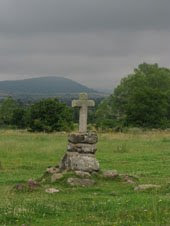
In France, that southerly drift of building materials had made sense, from the northern pale and hard stone to the dark granite and basalt of the volcanic centre and thence into the soft red bricks or sandstone of the south. We plotted the logical and techno-logical development from Romanesque to early, classic, rayonnant and flamboyant Gothic styles as the architects' confidence grew. We could sympathise when, in the far south, they turned their backs on Gothic's conceptual origins by 
Yet beyond the mountains it all goes opaque. So many of the churches doubled as fortresses, lending bodily as well as spiritual protection. Could that be why we're so lost? Or is it that the buildings leap straight from the Romanesque into Baroque, ignoring evolution with just an occasional toe on the stepping stone of very late "florid" Gothic. We try to read the cathedrals and monasteries as a textbook of building, just as we could in Normandy and Picardy, but we are left perplexed. Guide books use terms like "herrerian" and "plateresque", words which 
An alternative explanation for these odd leaps of architecture might be that the monasteries and cathedrals along the Spanish pilgrim routes were already going strong in the time when Romanesque was still the architecture of repute; and no one saw the need to fiddle with the magnificent buildings until the late sixteenth and seventeenth centuries, when South America brought Spain both fabulous wealth and the leading public relations job in holding back protestantism.
So in the Iglésia de Santiago in Puenta la Reina the Romanesque imagination in the portal has beasts and apostles, trees and demons in beautiful flat carving, and a looping fringe that hangs
In Torres del Rio there are traces of Moorish influence which reach even further back. The tiny Iglésia del San Sepulcro is a single-domed, octagonal graveside church that mingles elaborate, 
Some rare examples of 'real' Gothic surprise and delight us, but serve to confuse us further with how they got there. In Los Arcos the carved bays of the Gothic cloister are like fresh water after the Iglésia de Santa María's interior, where not an inch of the surface has been left unpainted or ungilded. The Iglésia de Santa María de Palacio in Logroño has a spikey steeple that is straight from Senlis in northern France. The wonderful Monastery of Santa María la Real in Nájera is rooted deeply in late Gothic and given its royal inheritance is a showpiece of humourous and naturalistic wood carving, in the darkly patina'd miserichords of the raised choir under roof vaults that are from the peak of Gothic conception.
Suddenly, in Burgos, there is a whole Cathedral whose external appearence, at least, is the direct cousin of northern French Gothic, from spiked steeple to arcade of kings.
But too often the bling of Baroque swept into these buildings and landed, gilded custard pie-like onto the Romanesque or Gothic structures. We had to peer hard to detect the good bones of the original under the cellulite ripplings of the seventeenth century in such places as the Iglésia de Santa María in Los Arcos, the Cathedral in Logroño or the many churches in Pamplona. Yet familiarity can sometimes confuse the senses and kill taste. With constant exposure we start to compare and make judgements. There are even moments when we think "it works", like in Puenta la Reina where somehow the austerity of the original church allowed it to carry the Baroque altar as an addition not an imposition.
Walking in half way through Mass in Navarette, I realised the service was in French and found myself giving the responses with everyone else, so stayed. As a fellow pilgrim, it appears the priest says Mass in the local church wherever he stops each night. There he stood in his white triangular robes with strips of gold in front of that soaring gold cacophony of an altar that is punctuated by vividly-painted statues of saints and apostles rising ever upwards. And for the first time I saw how it fitted. The priest with the outdated clothes and the over-the-top altar complimented each other in the same sense of mystic ceremony.
But in the face of the very ostentation of these churches the protestant roots of me rebelled. Bowing every time the priest mentioned Mary, Jesus or God reminded me of the rocking of Muslim or Jewish responses to words spoken; although in those religions I find nothing wrong with the idea. But saluting Mary first? No.
And the socialist roots in me couldn't accept that only the priest could taste the wine, quaffing deeply and rubbing the chalice with linen so every speck of red was removed from the danger of being touched by the populace. The rest had to be content with dry wafers. Jan Huss, where art thou? What happened to the right for everyone to commune "in both parts"? The self-satisfied trumpet blowing of Baroque gold must surely have lit the fires of both protestantism and revolution.
5th September 2008
Friday, 5 September 2008
Castles in Spain
Posted by
Rachel Escott
at
11:14
![]()








































































No comments:
Post a Comment